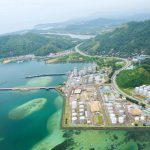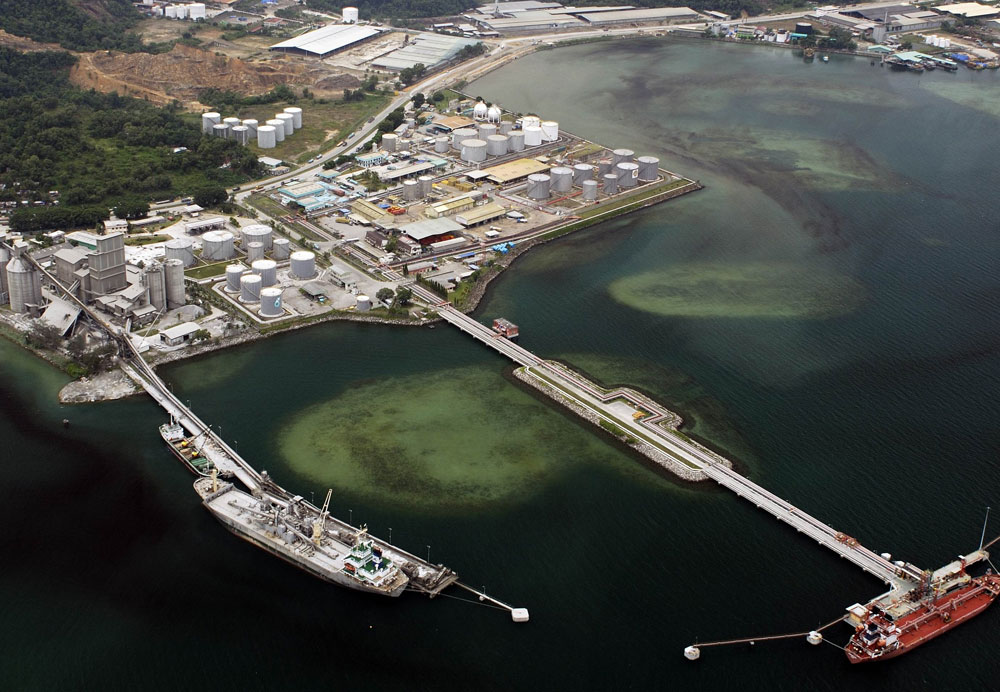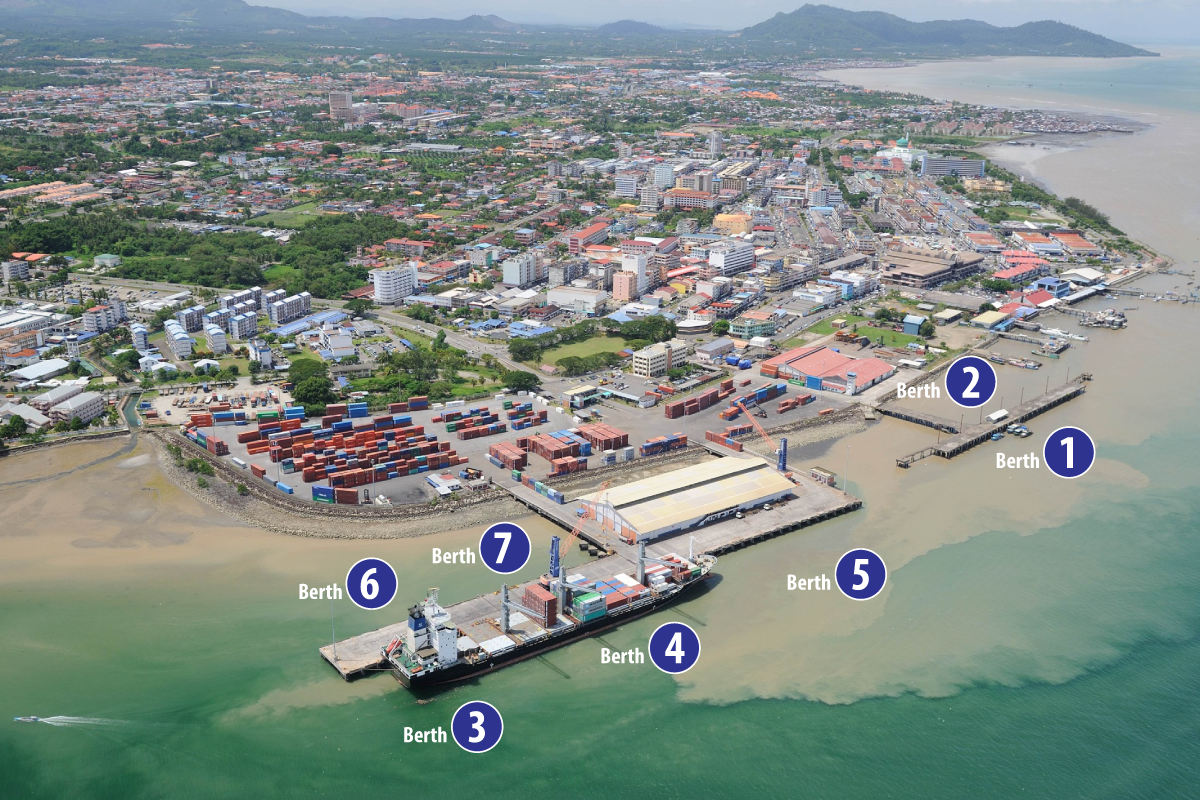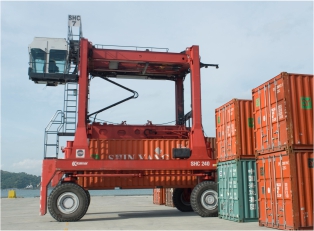







Sapangar Bay Container Port is a dedicated container facility and is positioned as the premier transhipment hub for the Brunei Darussalam-Indonesia-Malaysia-Philippines East ASEAN Growth Area (BIMP-EAGA). Kota Kinabalu Port handles general cargo, cruise vessels and also provides roll-on, roll-off services. Sapangar Bay Oil Terminal is a dedicated terminal for the handling of refined petroleum products and liquid chemical serving the west coast of Sabah.
The east coast ports of Sandakan, Tawau and Lahad Datu handle general cargo and containers as well as fertilizer and palm oil products. Kunak Port handles palm oil and palm kernel exports.
















The ports operate three shifts daily through all year round
| Shift | Hours | Rest |
|---|---|---|
| 1st shift | 0800 to 1600 hours | 1130 to 1230 hours |
| 2nd shift | 1600 to 2400 hours | 1830 to 1930 hours |
| 3rd shift | 0000 to 0800 hours | 0300 to 0330 hours |
Copyright © 2022 Sabah Ports Sdn. Bhd.
Sapangar Bay Container Port (SBCP) is strategically located along the busy shipping routes between the Far East and Europe. Plans are underway to rationalize the port operations statewide through hubbing to create economies of scale.
SBCP, which has taken over the container operations from Kota Kinabalu Port, is positioned as the premier transhipment hub for the Brunei Darussalam-Indonesia-Malaysia-Philippines East ASEAN Growth Area (BIMP-EAGA). A port of international standing, SBCP boasts of state-of-the-art facilities, the ability to handle more container volume, more efficient and effective operations and greater competitive freight charges.

Berth
| No. Of Berth | Berth 1, 2 & 3 (Outer Berth) | Berth 4 & 5 (Inner Berth) |
|---|---|---|
| Length (M) | 500 | 145 |
| Depth (M) | 12 | 12 |
| Max Vessel Size (DWT) | 45,000 | 45,000 |
Storage
Cargo Type
Mechanical Equipment






A dedicated terminal for refined petroleum and chemical products, the Sapangar Bay Oil Terminal is surrounded by major oil and gas facilities such as Shell, Esso and Petronas. Over 20 milllion Ringgit expansion plan is underway to add more berth and facilities to accommodate larger tankers and big scale supply of bunker and fresh water. It is poised to be “the oil and gas terminal hub” of the region.

Berth
| No. Of Berth | Main Berth | Inner Berth |
|---|---|---|
| Length (M) | 82.32 | 45.73 |
| Depth (M) | 12 | 12 |
| Max Vessel Size (DWT) | 30,000 | 1,000 |
Sapangar Bay Oil Storage and Distribution Depot
| Total Tank Capacity | 30,000 mt |
| Tank 1 | 4,000 mt |
| Tank 2 | 4,000 mt |
| Tank 3 | 4,000 mt |
| Tank 4 | 4,000 mt |
| Tank 5 | 2,500 mt |
| Tank 6 | 2,500 mt |
| Tank 7 | 2,500 mt |
| Tank 8 | 2,500 mt |
| Tank 9 | 4,000 mt |
| Gantry Bay | 6 units |
Pipeline
| Pipeline | Type Size | Product | Equipment |
|---|---|---|---|
| Common | 10" | RON 97 | Marine Loading Arm |
| Common | 10" | JET AI | Marine Loading Arm |
| Common | 10" | RON 95 | Marine Loading Arm |
| Common | 10" | ADO | Marine Loading Arm |
| Common | 10" | MFO | Marine Loading Arm |
| Common | 10" | Bitumen | Flexible Hose |
| Common | 6" | LPGL | Flexible Hose |
| Common | 3" | LPGV | Flexible Hose |
| Common | 8" | ADO | Flexible Hose / Bunkering |
| Common | 10" | MFO | Flexible Hose / Bunkering |
| Common | 6" | Fresh Water | Flexible Hose |
Cargo Type
Mechanical Equipment


A new era will unfold with the development of Jesselton Quay at Kota Kinabalu Port. Jesselton Quay is poised to be the new landmark of the state where one can dine, shop, and enjoy entertaiment by-the-sea. Kota Kinabalu Port is one of Sabah’s earliest and main ports. It used to handle a variety of cargo.
But today, Sapangar Port has taken over the major port role, and thus Kota Kinabalu Port only handles non-containerized cargo such as general cargo and dry bulk.

Berth
| No. Of Berth | Berth 1, 2 & 3 | Berth 4 | Berth 5 & 6 | Berth 7 |
|---|---|---|---|---|
| Length (M) | 350 | 120 | 200 | 120 |
| Depth (M) | 9.6 - 9.8 | 6.2 - 9.5 | 5.3 - 6.7 | 7.4 - 8.6 |
| Max Vessel Size (DWT) | 16,000 | 16,000 | 16,000 | 16,000 |
Storage
Cargo Type
Mechanical Equipment



Kudat Port’s closer proximity to the Philippines makes it a top choice for maritime trade to the archipelago. The port mostly handles general cargo and timber-related products.

Berth
| No. Of Berth | Inner Berth | Outer Berth | Passenger Ferry Terminal | Ferry Ramp (Ro-Ro) |
|---|---|---|---|---|
| Length (M) | 112 | 92 | 24 | 69 |
| Depth (M) | 6.2 | 6.4 | 3-4 | 3-4 |
| Max Vessel Size (DWT) | 4,000 | 1,000 | 1,000 |
Storage
Cargo Type
Mechanical Equipment

The second busiest port in Sabah, is located at the East Coast of Sabah, which is renowned for its palm oil industry. Besides palm oil related products, the port also handles container, general cargo and dry bulk.

Berth
| Main Wharf (4) | Berth 1 | Berth 2A (Outer) | Berth 2B (Inner) | Berth 3 | Berth 4 |
|---|---|---|---|---|---|
| Length (M) | 213 | 281 | 241 | 76 | 155 |
| Depth (M) | 10 | 10 | 6 | 6 | 9 |
| Max Vessel Size (DWT) | 20,000 |
| Oil Terminals (3) | Karamunting Bulk Oil Terminal | Karamunting Palm Oil Terminal | Mowtas Oil Terminal |
|---|---|---|---|
| Length (M) | 170 | 200 (Outer) 130 (Inner) | 170 |
| Depth (M) | 9.4 | 11.1 (Outer) 10.2 (Inner) | 9 |
| Max Vessel Size (DWT) | 30,000 | 45,000 (Outer) 8,000 (Inner) | 20,000 |
Storage
Cargo Type
Mechanical Equipment







Tawau port is located on the East coast of Sabah. Its strategic location and close proximity to the Kalimantan Borneo is a catalyst for the port business, providing the port with vast business potential. The multipurpose port is equipped with various essential facilities to support the handling of various cargo types.
Tawau port is now considered a major port in the East coast for the volume it handles, second to Sandakan port.

Berth
| No. of Berth | Main Wharf | Berth 6 & 7 (Inner Berth) | Berth 3, 4 & 5 (Outer Berth) | Tanjung Batu Oil Jetty |
|---|---|---|---|---|
| Length (M) | 170 | 302 | 76 | |
| Depth (M) | 5.5 | 11 | 9 | |
| Max Vessel Size (DWT) | 16,000 | 16,000 | 16,000 | 30,000 |
Storage
Cargo Type
Mechanical Equipment








Lahad Datu Port is strongly supported by the palm oil industry. With the up and coming Palm Oil Industrial Cluster (POIC) Lahad Datu, Lahad Datu Port is poised to be a catalyst in the booming palm oil industry as well as oleo chemical and bio diesel industry in East Malaysia.
Lahad Datu is also set to be the Central Hub for the import of Bulk Fertilizer for the East Coast. With so much promise of growth, Lahad Datu is destined to be “The Rotterdam of the East”.

Berth
| Main Wharf (3) | Berth 3 (Side Berth) | Berth 4 (Outer Berth) | Berth 5 (Inner Berth) |
|---|---|---|---|
| Length (M) | 100 | 190 | 140 |
| Depth (M) | 9 | 12 | 9 |
| Max Vessel Size (DWT) | 9,000 | 45,000 | 9,000 |
| Old Wharf (2) | Berth 1 (Outer Berth) | Berth 2 (Inner Berth) |
|---|---|---|
| Length (M) | 97 | 73 |
| Depth (M) | 9.3 | 8.5 |
| Max Vessel Size (DWT) | 25,000 | 2,000 |
Storage
Cargo Type
Mechanical Equipment







Kunak Port serves as a dedicated crude palm oil port. With a boost from major palm oil players, it is projected that 1.4 million tones of palm oil will be handled by Kunak Port, making it a major palm oil port. Plans are underway to make Kunak Port become the East Coast’s Central Hub for the export of Palm Kernel Expeller.

Berth
| No. Of Berth | Berth 1 | Berth 2 | Berth 3 | Berth 4 |
|---|---|---|---|---|
| Length (M) | 200 | 190 | 70 | 120 |
| Depth (M) | 17 | 17 | 17 | 11 |
| Max Vessel Size (DWT) | 45,000 | 45,000 | 45,000 | 28,000 |
Storage
Cargo Type
Mechanical Equipment

